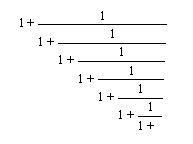a. Construct the ratio of each pair of adjacent terms in the Fibonnaci sequence. What happens as n increases? What about the ratio of every second term? etc.
b. Explore sequences where f(0) and f(1) are some arbitrary integers other than 1. If f(0)=1 and f(1) = 3, then your sequence is a Lucas Sequence. All such sequences, however, have the same limit of the ratio of successive terms.
| n | f(0)=1, f(1)=1 | Ratio=f(n)/f(n-1) | f(0)=3, f(1)=4 | Ratio=f(n)/f(n-1) |
| 0 | 1 | 3 | ||
| 1 | 1 | 1 | 4 | 1.33333333333333 |
| 2 | 2 | 2 | 7 | 1.75 |
| 3 | 3 | 1.5 | 11 | 1.57142857142857 |
| 4 | 5 | 1.66666666666667 | 18 | 1.63636363636364 |
| 5 | 8 | 1.6 | 29 | 1.61111111111111 |
| 6 | 13 | 1.625 | 47 | 1.62068965517241 |
| 7 | 21 | 1.61538461538462 | 76 | 1.61702127659574 |
| 8 | 34 | 1.61904761904762 | 123 | 1.61842105263158 |
| 9 | 55 | 1.61764705882353 | 199 | 1.61788617886179 |
| 10 | 89 | 1.61818181818182 | 322 | 1.61809045226131 |
| 11 | 144 | 1.61797752808989 | 521 | 1.61801242236025 |
| 12 | 233 | 1.61805555555556 | 843 | 1.61804222648752 |
| 13 | 377 | 1.61802575107296 | 1364 | 1.61803084223013 |
| 14 | 610 | 1.61803713527851 | 2207 | 1.61803519061584 |
| 15 | 987 | 1.61803278688525 | 3571 | 1.6180335296783 |
| 16 | 1597 | 1.61803444782168 | 5778 | 1.61803416409969 |
| 17 | 2584 | 1.61803381340013 | 9349 | 1.61803392177224 |
| 18 | 4181 | 1.61803405572755 | 15127 | 1.61803401433308 |
| 19 | 6765 | 1.61803396316671 | 24476 | 1.61803397897799 |
| 20 | 10946 | 1.6180339985218 | 39603 | 1.61803399248243 |
| 21 | 17711 | 1.61803398501736 | 64079 | 1.61803398732419 |
| 22 | 28657 | 1.6180339901756 | 103682 | 1.61803398929446 |
From the table above we can see that two fibonnaci sequences with different starting points converge to the same point in the ratio of each pair of adjacent terms.
Of course, the ratio does not increase as n inreases but it goes towards a particular value.
we can notice the value is a golden ratio.
Golden Ratio

| n | f(0)=1, f(1)=3 | Ratio=f(n)/f(n-1) |
| 0 | 1 | |
| 1 | 3 | 3 |
| 2 | 4 | 1.33333333333333 |
| 3 | 7 | 1.75 |
| 4 | 11 | 1.57142857142857 |
| 5 | 18 | 1.63636363636364 |
| 6 | 29 | 1.61111111111111 |
| 7 | 47 | 1.62068965517241 |
| 8 | 76 | 1.61702127659574 |
| 9 | 123 | 1.61842105263158 |
| 10 | 199 | 1.61788617886179 |
| 11 | 322 | 1.61809045226131 |
| 12 | 521 | 1.61801242236025 |
| 13 | 843 | 1.61804222648752 |
| 14 | 1364 | 1.61803084223013 |
| 15 | 2207 | 1.61803519061584 |
| 16 | 3571 | 1.6180335296783 |
| 17 | 5778 | 1.61803416409969 |
| 18 | 9349 | 1.61803392177224 |
| 19 | 15127 | 1.61803401433308 |
| 20 | 24476 | 1.61803397897799 |
| 21 | 39603 | 1.61803399248243 |
| 22 | 64079 | 1.61803398732419 |
Return to Hyungsook's homepage